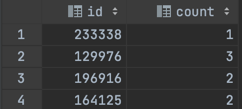Querying Nested JSON in PostgreSQL
The core of this technique can be distilled into this query.
SELECT *
FROM orders,
LATERAL json_array_elements(orders.raw_payload -> 'line_items') json_line_item
If there’s even a single word from this query you don’t quite understand, you are in the right place.
Schema and test data
Before we get started with queries, let me introduce a simple schema.
CREATE TABLE orders (
id int PRIMARY KEY,
raw_payload json
)
raw_payload is just a content from Shopify’s order object. It’s going to give us plenty to work for as typical order contains ~400 lines of JSON.
For the purposes of this articles, imagine the payload only contains:
{
"line_items": [
{
"id": 1,
"discount_allocations": [
{
"amount_set": {
"shop_money": {
"amount": "10.30",
"currency": "GBP"
}
}
}
]
},
{
"id": 2,
"discount_allocations": []
}
]
}
With order like this, someone purchased 2 products, and one of them received £10.30 discount
Now that we understand the data, we can start digging into it.
Lateral join with json
This example is build on 2 important and not so often used parts. First one is json_array_elements (or jsonb_array_elements) and second LATERAL JOIN.
json_array_elements
It expands an array inside a JSON into an set of jsons as individual rows. These value will be available under new value column
If we look at example from PostgreSQL’s documentation:
SELECT *
FROM json_array_elements('[1, true, [2, false]]')
Will get turned into a result with 3 rows:

LATERAL join
Now let’s tackle the LATERAL part. Think of it as a each from a typical programming language. It allows you join a different set of rows while giving you an access to an individual row from the previous association.
In our example we are using
SELECT orders.id, json_line_item
FROM orders,
LATERAL json_array_elements(orders.raw_payload -> 'line_items') json_line_item
which would produce

Let’s break down each part of the syntax:
->access json key and return it as json field. Same asraw_payload.line_itemsin Javascript, orraw_payload['line_items']in Rubyjson_array_elementsexpand array of jsons into rows- for each order, add the newly created rows from
json_array_elements json_line_itemcall the newly created columnjson_line_item
Real world examples
Now that we know the basics of querying jsons, let’s answer a few answers.
Q: How many line items does each order have?
SELECT orders.id, COUNT(json_line_item)
FROM orders,
LATERAL JSONB_ARRAY_ELEMENTS(orders.raw_payload -> 'line_items') shopify_line_items(json_line_item)
GROUP BY 1

Q: Report discounts for all line items and orders
SELECT orders.id AS order_id,
json_line_item -> 'id' AS line_item_id,
discount_allocation -> 'amount_set' -> 'shop_money' ->> 'amount' AS discount_pounds
FROM orders,
LATERAL JSONB_ARRAY_ELEMENTS(orders.raw_payload -> 'line_items') json_line_item,
LATERAL JSONB_ARRAY_ELEMENTS(json_line_item -> 'discount_allocations') discount_allocations(discount_allocation)

This technique was shown to me by @pawelpacana. You won’t regret his content.
If you have any comments of feedback, engage on
Do you know how to query nested JSON in @PostgreSQL as if it were tables?
— Miroslav Csonka (@miroslavcsonka) March 22, 2021
If not go to https://t.co/JsByQbnxzO for a walkthrough of every single word from the query pic.twitter.com/jiKfkfUD3U
or
Querying Nested Json In Postgres from r/PostgreSQL